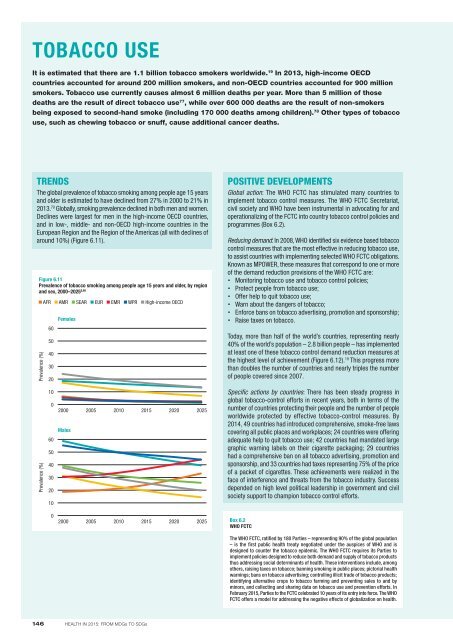Create successful ePaper yourself
Turn your PDF publications into a flip-book with our unique Google optimized e-Paper software.
TOBACCO USE<br />
It is estimated that there are 1.1 billion <strong>to</strong>bacco smokers worldwide. 19 In 2013, high-income OECD<br />
countries accounted for around 200 million smokers, and non-OECD countries accounted for 900 million<br />
smokers. Tobacco use currently causes almost 6 million deaths per year. More than 5 million of those<br />
deaths are the result of direct <strong>to</strong>bacco use 77 , while over 600 000 deaths are the result of non-smokers<br />
being exposed <strong>to</strong> second-hand smoke (including 170 000 deaths among children). 78 Other types of <strong>to</strong>bacco<br />
use, such as chewing <strong>to</strong>bacco or snuff, cause additional cancer deaths.<br />
TRENDS<br />
The global prevalence of <strong>to</strong>bacco smoking among people age 15 years<br />
and older is estimated <strong>to</strong> have declined <strong>from</strong> 27% in 2000 <strong>to</strong> 21% in<br />
2013. 79 Globally, smoking prevalence declined in both men and women.<br />
Declines were largest for men in the high-income OECD countries,<br />
and in low-, middle- and non-OECD high-income countries in the<br />
European Region and the Region of the Americas (all with declines of<br />
around 10%) (Figure 6.11).<br />
Figure 6.11<br />
Prevalence of <strong>to</strong>bacco smoking among people age 15 years and older, by region<br />
and sex, 2000–2025 8,80<br />
Prevalence (%)<br />
AFR AMR SEAR EUR EMR WPR High-income OECD<br />
60<br />
50<br />
40<br />
30<br />
20<br />
Females<br />
POSITIVE DEVELOPMENTS<br />
Global action: The WHO FCTC has stimulated many countries <strong>to</strong><br />
implement <strong>to</strong>bacco control measures. The WHO FCTC Secretariat,<br />
civil society and WHO have been instrumental in advocating for and<br />
operationalizing of the FCTC in<strong>to</strong> country <strong>to</strong>bacco control policies and<br />
programmes (Box 6.2).<br />
Reducing demand: In 2008, WHO identified six evidence based <strong>to</strong>bacco<br />
control measures that are the most effective in reducing <strong>to</strong>bacco use,<br />
<strong>to</strong> assist countries with implementing selected WHO FCTC obligations.<br />
Known as MPOWER, these measures that correspond <strong>to</strong> one or more<br />
of the demand reduction provisions of the WHO FCTC are:<br />
• Moni<strong>to</strong>ring <strong>to</strong>bacco use and <strong>to</strong>bacco control policies;<br />
• Protect people <strong>from</strong> <strong>to</strong>bacco use;<br />
• Offer help <strong>to</strong> quit <strong>to</strong>bacco use;<br />
• Warn about the dangers of <strong>to</strong>bacco;<br />
• Enforce bans on <strong>to</strong>bacco advertising, promotion and sponsorship;<br />
• Raise taxes on <strong>to</strong>bacco.<br />
Today, more than half of the world’s countries, representing nearly<br />
40% of the world’s population – 2.8 billion people – has implemented<br />
at least one of these <strong>to</strong>bacco control demand reduction measures at<br />
the highest level of achievement (Figure 6.12). 19 This progress more<br />
than doubles the number of countries and nearly triples the number<br />
of people covered since 2007.<br />
Prevalence (%)<br />
10<br />
0<br />
60<br />
50<br />
40<br />
30<br />
20<br />
10<br />
2000 2005 2010 2015 2020 2025<br />
Males<br />
Specific actions by countries: There has been steady progress in<br />
global <strong>to</strong>bacco-control efforts in recent years, both in terms of the<br />
number of countries protecting their people and the number of people<br />
worldwide protected by effective <strong>to</strong>bacco-control measures. By<br />
2014, 49 countries had introduced comprehensive, smoke-free laws<br />
covering all public places and workplaces; 24 countries were offering<br />
adequate help <strong>to</strong> quit <strong>to</strong>bacco use; 42 countries had mandated large<br />
graphic warning labels on their cigarette packaging; 29 countries<br />
had a comprehensive ban on all <strong>to</strong>bacco advertising, promotion and<br />
sponsorship, and 33 countries had taxes representing 75% of the price<br />
of a packet of cigarettes. These achievements were realized in the<br />
face of interference and threats <strong>from</strong> the <strong>to</strong>bacco industry. Success<br />
depended on high level political leadership in government and civil<br />
society support <strong>to</strong> champion <strong>to</strong>bacco control efforts.<br />
0<br />
2000 2005 2010 2015 2020 2025<br />
Box 6.2<br />
WHO FCTC<br />
The WHO FCTC, ratified by 180 Parties – representing 90% of the global population<br />
– is the first public health treaty negotiated under the auspices of WHO and is<br />
designed <strong>to</strong> counter the <strong>to</strong>bacco epidemic. The WHO FCTC requires its Parties <strong>to</strong><br />
implement policies designed <strong>to</strong> reduce both demand and supply of <strong>to</strong>bacco products<br />
thus addressing social determinants of health. These interventions include, among<br />
others, raising taxes on <strong>to</strong>bacco; banning smoking in public places; pic<strong>to</strong>rial health<br />
warnings; bans on <strong>to</strong>bacco advertising; controlling illicit trade of <strong>to</strong>bacco products;<br />
identifying alternative crops <strong>to</strong> <strong>to</strong>bacco farming and preventing sales <strong>to</strong> and by<br />
minors, and collecting and sharing data on <strong>to</strong>bacco use and prevention efforts. In<br />
February 2015, Parties <strong>to</strong> the FCTC celebrated 10 years of its entry in<strong>to</strong> force. The WHO<br />
FCTC offers a model for addressing the negative effects of globalization on health.<br />
146 HEALTH IN 2015: FROM MDGs TO SDGs


